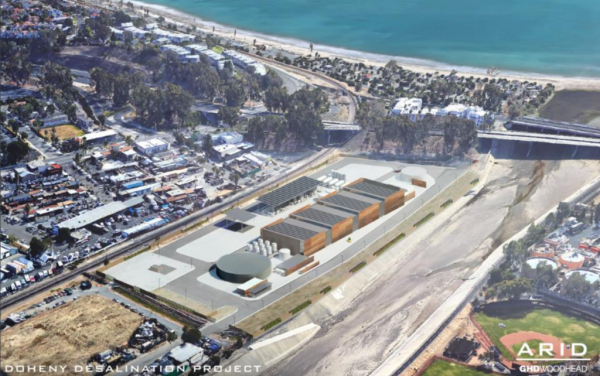SCWD clears environmental review of planned desalination facility
By Daniel Langhorne, Special to the Independent
The South Coast Water District approved an environmental impact report Thursday, June 27, for the proposed Doheny Desalination Facility that could provide the region with up to 5 million gallons of water per day.

SCWD’s Board of Directors voted 4-1, Director Doug Erdman abstained, to approve the EIR’s findings which determined the project wouldn’t have any significant impacts that cannot be mitigated. The report also identified 40 mitigation measures to limit the environmental impacts on air quality, biological resources, greenhouse gas emissions, water quality, recreation, utilities, and other concerns.
“I believe if there was a fatal flaw in the environmental component, and that’s what we’re talking about here tonight, I think it would be glaringly obvious,” Director Rick Erkeneff said. “If there’s an approval tonight, it by no means is a green light to put a shovel in the ground.”
The desalination facility is proposed at a site next to San Juan Creek and north of Pacific Coast Highway. It would initially serve the 35,000 residents in the SCWD service area, including those in South Laguna Beach, as well as 1,000 businesses and two million visitors per year.
District counsel Arthur Kidman advised the directors that they should keep their questions and comments focused on the environmental study rather than public policy questions such as the project’s cost and whether SCWD should move forward without partnership agreements with other water agencies in the region.
One of the big concerns expressed by Dana Point residents and Director Dennis Erdman is the effectiveness of a new method for drilling slantwise under the ocean floor to collect seawater without sucking up marine life into the system’s intake pipes.
“I do share concerns about the slant wells because of the maturity of that particular endeavor,” Erdman said. “We don’t have a long history there and the slant wells are critical to this project and if they don’t work then the project doesn’t work.”
Kevin Thomas, a senior manager with district consultant Kimley-Horn, said that a slant well was successfully tested at Doheny State Beach and another is in operation in Monterey Bay.
Capistrano Beach resident Toni Nelson said she is concerned about the relatively unproven technology but is also concerned about a relatively small population being saddled with the desalination facility’s cost.
“We only have 36,000 people here in our rate district and you’re asking us to take on about $100 million in debt and I’m worried about that,” Nelson said. “I’m worried about that as a ratepayer and as a CPA myself.”
Roger Butow, a Laguna Beach resident and executive director of Clean Water Now, argued the SCWD Board of Directors made a mistake by moving forward with a project that relies on unproven technology and without regard to the costs that will be shouldered by future generations.
“None of these people, board or staff, will be around to take the blame when customer’s children and grandchildren are experiencing higher rates and trying to pay off the unreasonable burden decades down the road,” Butow said.
District General Manager Rick Shintaku anticipates it will take about 10 million gallons of seawater to create 5 million gallons of clean drinking water at the proposed desalination facility. The energy required for this process is anticipated to equal about a third of the power used in Dana Point, Erdman said.
A fear among water agencies in Southern California is that a major earthquake could cut off aqueducts bringing in water from the Sacramento Delta, Sierra Nevada snowpack, and Colorado River. The Metropolitan Water District of Orange County has warned local water agencies like SCWD that they need to prepare to go without this imported water for up to 60 days.
This would create a huge emergency because SCWD, like other South Orange County water districts, imports almost 90 percent of its water. If the desalination plant is approved, SCWD will be able to create enough drinking water to sustain itself for well over 60 days, Shintaku said.
Mandy Sackett, a state policy coordinator for the Surfrider Foundation, said the state legislature recently mandated a per capita usage of 50 gallons per day by 2030 and pointed out that SCWD customers currently use 94.4 gallons per day. She argued this shows SCWD has more work to do on encouraging customers to conserve water.
“While it’s not opposition to desalination in concept, Surfrider Foundation supports maximization of water recycling efforts before considering desalination,” Sackett said. “We hope the District will take these mandates into account especially when considering future expansion plans.”
A cost estimate for the Desalination Facility is expected to be complete in the next two to three months, and a series of public workshops will be scheduled to discuss those figures, Shintaku said. It could take at least another year before the Coastal Commission weighs in on granting SCWD a coastal development for the Desalination Facility.





It’s really a prototype, so why is SCWD underwriting a prototype system originally launched by MWDOC?
Slant wells were THEIR idea/choice over 10 years ago when a partner in this, before, like Laguna Beach, San Clemente, San Juan Capo & Moulton Niguel Water Districts dropped out to leave SCWD going it alone.
By refusing to EVER consider vertical wells (less expensive, proven track record) there’s no way to separate the intake extraction tactic/engineering risks from the cost.
Let MWDOC come back, reclaim lead or co-lead, form a SOC regional JPA that includes cost sharing….SCWD gets reimbursed, maybe weighted voting on the JPA Board and/or reduced rates to compensate for carrying the load alone these past 5-6 years?
If this isn’t a regional production project with numerous partners, shared costs & expenditures for construction + Operation & Maintenance, then it adds a huge mountain of debt to a District already in the red due to the South Laguna Tunnel Project—In progress, also under-funded.
Hoping for help is not a sound fiscal strategy.